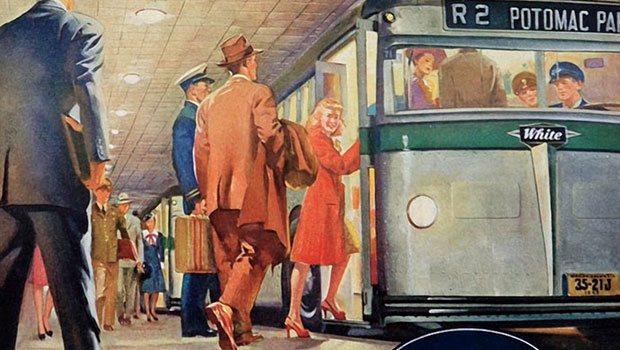Scanning Around with Gene: And Leave the Driving to Us!

I’ve never hopped a freight train or even hitchhiked across America. But I have ridden on a Greyhound bus, and I can say without hesitation that bus travel has no romantic connotations for me and is an option of last resort. But since bus travel is typically the cheapest way to get from one place to another, I realize my views are elitist. Most bus travelers would likely choose another method if they could.
The image of bus travel has become so poor that we now use it as the lowest measure on the public conveyance scale. When airfares became dirt cheap after deregulation, how many times did you hear someone say something like “Air travel use to be special, but now even the bus crowd is flying.”
Click on any of these images for a larger version.


Like all bigotry, our image of bus riders as somehow undesirable is often based on a personal (if narrow) experience. If you’ve ridden on Greyhound, you’ve cringed and avoided eye contact when certain passengers board, looking at that empty seat next to you. The likelihood of an engaging, polite, and well-behaved seatmate is probably high, but we tend to focus on the few who are talking to imaginary demons and in need of a bath. Thus we pay extra to travel by air or train or car.


But that wasn’t always an option. Bus travel has generally mirrored various eras in the United States, good and bad. Busses played a significant role in the civil rights movement, and bus riders have been concerned about who sits next to them for all kinds of reasons.
The black-and-white photos in this article were all taken by Esther Bubley on a 1943 Greyhound bus trip throughout the eastern half of America. Bubley was part of the photographic effort funded by the Farm Services Administration, and these photos are in the Library of Congress collection. Here is Greyhound driver Bernard Cochran (top), and another unidentified driver from Columbus, Ohio.


America is a big place, and even though we did build a decent cross-country rail system, our transportation infrastructure has always been big-city oriented, or existed primarily for commercial, not passenger service. So bus travel quickly became the norm for anyone travelling from one small town to another, and bus companies sprang up all over the country.


Greyhound, for example, which became the largest among nationwide bus carriers, began in 1914 in Hibbing, Minnesota, with a single Hupmobile ferrying iron-ore miners back and forth between Hibbing and Alice for 15 cents. By the 1940s, Greyhound had over 4,750 stations and nearly 10,000 employees. Here, a Grehound station in Washington DC, another in Indianapolis, Indiana, and another along the highway in Indiana.



The architecture of bus terminals is another subject entirely, but Greyhound in particular built many stations during the art-deco period of design, such as this one in Cincinnati, Ohio.

Go to page 2 for many more images, and for Gene’s thoughts on everything from civil rights to canine companions.
This article was last modified on May 18, 2023
This article was first published on October 24, 2008



